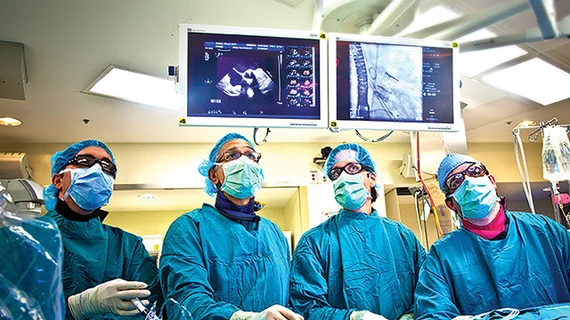Patients with severe but asymptomatic aortic stenosis have better survival two and three years later if an aortic valve replacement (AVR) is initially recommended instead of a “watchful waiting” approach, according to a single-center study published in The Annals of Thoracic Surgery.
The study included 265 patients seen at Northwestern Medicine in Chicago from 2005 through 2013 who were deemed to have severe, asymptomatic aortic stenosis upon echocardiography. Thirty-nine percent of these patients were recommended to undergo AVR while 61 percent received a recommendation for watchful waiting (WW).
Although there wasn’t a statistically significant difference in survival one year after the recommendations were given—death rates were 5.2 percent in the WW group and 4.7 percent in the AVR group—the gap became more pronounced after that. Two-year mortality was 16.1 percent for WW and 7.5 percent for AVR, while three-year mortality was 21.1 percent and 9.0 percent, respectively.
Overall, the researchers said a wait-and-see approach appears to be relatively safe for one year, but also carries the risk that timely intervention won’t be offered once symptoms actually develop. Watchful waiting requires patients to recognize and promptly report their symptoms, which doesn’t always happen.
“A possible explanation for the failure of expectant management in the WW group is the inability to capture patients during symptom onset and subsequently treat with timely AVR,” senior author S. Chris Malaisrie, MD, and colleagues wrote. “Although 28 percent of patients in the WW group did undergo AVR by 2 years, an additional 16 percent of patients died during the same interval. This differential in event rates suggests a missed opportunity to identify patients meeting the indication for AVR.”
Malaisrie et al. found that following through on surgery for the AVR-recommended group was associated with an 83 percent better chance of survival. Patients in the WW group who ended up getting operations also saw survival odds boosted by 61 percent.
“It is important for patients to know that severe aortic stenosis, even when there are no symptoms, carries a poor outcome, if left untreated,” Malaisrie said in a press release.
“The results of this study suggest a fundamental change is needed in how we care for patients with narrowing of the aortic valve,” Todd K. Rosengart, MD, of Baylor College of Medicine, said in the same release. Rosengart wasn’t directly involved in the study.
“This advance would mirror what we already know and practice in caring for disease of the other major heart valve—the mitral valve—that you don’t need to and probably shouldn’t wait until symptoms develop to correct significant dysfunction of the heart valves.”
Of the 172 patients in the study who underwent AVR, only five received transcatheter aortic valve replacement (TAVR) while the rest received surgical AVR (SAVR). But two TAVR versus SAVR trials presented at the American College of Cardiology’s scientific sessions this month suggested TAVR is at least as good as SAVR for low-risk patients, if not better.
Malaisrie et al.’s study was limited by differences in patient characteristics between recommendation groups, along with a lack of information on other factors that could have affected clinical decision-making, such as concomitant diseases or provider bias for one strategy over another. Nevertheless, the results point to the importance of prompt valve replacement, whether it come via TAVR or SAVR.
“Our data suggest that those patients who ultimately did undergo AVR derived a similar survival benefit regardless of recommendation group (as long as they had AVR),” the authors wrote. “This finding highlights that the failure of expectant management in the WW group may be entirely a result of the failure to recognize symptom onset and treat with timely AVR.”

